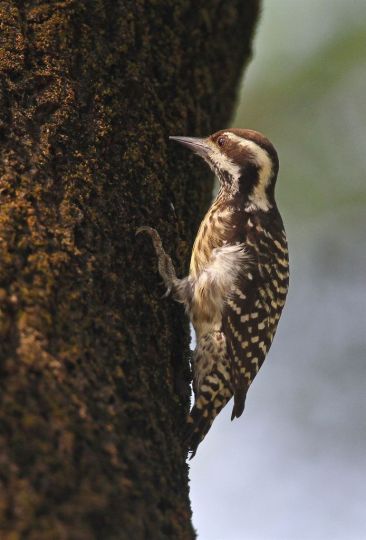Philippine Woodpecker Dendrocopos Maculatus.This is the race validirostris. Also commonly known as Philippine Pygmy Woodpecker and locally as just Pygmy Woodpecker. It is endemic to the Philippines, but is not found on all of the islands. Its local name in Kapampangan is Anluage. Its natural habitats are subtropical or tropical moist lowland forests and subtropical or tropical moist montane forests.
This species has a very large range, and hence does not approach the thresholds for Vulnerable under the range size criterion (Extent of Occurrence <20,000 km2 combined with a declining or fluctuating range size, habitat extent/quality, or population size and a small number of locations or severe fragmentation). The population trend appears to be stable, and hence the species does not approach the thresholds for Vulnerable under the population trend criterion (>30% decline over ten years or three generations). The population size has not been quantified, but it is not believed to approach the thresholds for Vulnerable under the population size criterion (<10,000 mature individuals with a continuing decline estimated to be >10% in ten years or three generations, or with a specified population structure). For these reasons the species is evaluated as Least Concern.
Forestory Project: Sablayan, Occidental Mindoro
December 2008 to December 2012
Donor: Value Frontier and BirdLife Asia
The project’s overall objective is to restore immediately the seven (7) hectares of denuded forestlands within Sitio Palbong, Barangay Batong-buhay using the rainforestation technology.
2012 Updates:
- 12-hectare of degraded forest planted with native tree species maintained.
- 27 native tree species planted consisting majority of Amugis (Koodersiodendron pinnatum), Bangkal(Nauclea orientalis), Bogo (Garuga floribunda), Dulitan (Palaquium Merrilli), Kalumpit (Terminalia microcarpa), Kupang (Parkia roxburghii), Mala-santol (Sandoricum vidalii), Malugai (Pometia pinnata), Narra (Pterocarpus indicus), Nato (Poloquium luzoniense), Pahutan (Mangifera altissima), Tuai (Bischofiajavanic), Bangkal (Neonauclea sp), Tulibas tilos (Micromelon compressum), Kamagong (Diospyros philippinensis), Alakaak (Palaquium philippinense), Yakal Saplungan (Hopea plagata) Tipuso (Litsea glutinosa), and other native species in small quantity with an 84 percent survival rate.
- Sightings of various bird species in the planted site such as Philippine Pygmy Woodpecker (Dendrocopos maculatus), Yellow vented Bulbul (Pycnonotus goiavier), Philippine Bulbul (Hypsipetes philippinus), Olive-backed Sunbird (Nectarinia jugularis), Purple- throated Sunbird (Nectarinia sperata), Black-naped Oriole (Oriolus chinensis), Philippine Coucal (Centropus viridis), Blue-crowned Racquet-tail (Prioniturus discurus) and Philippine Duck (Anas luzonica) observed.
- Sixty-four (64) members of the People’s Organization (PO) benefitted from the project with an additional average income of Php341.00 per month per member.
2011 Updates:
- 10.59 hectares planted with 77% survival rate (71% in rate in March 2012)
- New shoots discovered from seedlings that were already wilting in the previous months.
- Increase in the average height and in the crown width of the seedlings.
- Total of 64 members of Palbong-CBFMA benefited from the project by receiving an additional average income of PhP782.97 per month from April 2011 to January 2012.
-ANSAY,ALLYSSAH BIANCA V.

